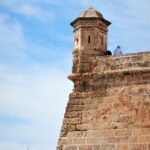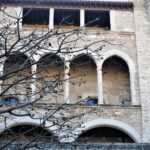 I love architecture. My family will confirm this, as they have often joined my meanderings down cobblestone streets or busy sidewalks to view a building. And so it was when Dave and I recently visited Palma de Mallorca, one of the Balearic Islands off the coast of Spain. We were on our way to see Ian and Claire in England, but we can’t get to where they live by direct flight. Usually, we change planes in Amsterdam, but this time I decided to mix it up a bit and go via Palma. We arrived at 8:00 in the morning and caught the next day’s 12:30 flight. So it was a whirlwind tour.
I love architecture. My family will confirm this, as they have often joined my meanderings down cobblestone streets or busy sidewalks to view a building. And so it was when Dave and I recently visited Palma de Mallorca, one of the Balearic Islands off the coast of Spain. We were on our way to see Ian and Claire in England, but we can’t get to where they live by direct flight. Usually, we change planes in Amsterdam, but this time I decided to mix it up a bit and go via Palma. We arrived at 8:00 in the morning and caught the next day’s 12:30 flight. So it was a whirlwind tour.
The island has a long, exciting history, and the buildings reflect the various cultures from the early Romans to Art Deco in the 20th century. While I knew the Moors occupied Spain for centuries, I hadn’t realized it included the islands. And their influence is evident. I set out to learn more about them.
So who were the Moors that had such an impact on the island? The term Moor is a word outsiders use to identify the Berbers from the Maghreb region of Northern Africa. Its root is in the Greek word mavro, meaning dark or black, and refers to the people who conquered and settled in Spain and Portugal in the 9th century.
The location of the Balearic islands, the largest of which is Mallorca, was ideal for trade. International commerce thrived with nautical routes convenient to Spain, France, and Northern Africa. Piracy also prospered. In 707, Musa ibn Nusair, governor of the Umayyad caliphate in North Africa,  raided the island. But it wasn’t until 903 that another ruler of the caliphate, Issam al-Khawlani, conquered the island.
raided the island. But it wasn’t until 903 that another ruler of the caliphate, Issam al-Khawlani, conquered the island.
Known at that time as Madina Mayurqa, the city prospered despite political turmoil in other parts of the world. Defensive walls, much of which still exist, were built. And the labyrinth of city streets was laid out. These were designed to take advantage of the coastal breezes and create shaded refuges from the hot summer sunshine.
In 1229, King James I of Aragon conquered the island on behalf of the Christian kingdoms. While the city fell within the first year, Muslim resistance held out for three years before the island finally succumbed. Afterward, King James I divided the land amongst the nobles who assisted him. He then moved on to take back Ibiza, a neighboring island.
 While the grand Mosque, built to hold 18,000 worshippers, no longer exists, and many other buildings have been destroyed or remodeled, there are still hints of the people who once dominated the island. The only Moorish building remaining in Palma is the 10th-century Banys Arabs (Arab Baths). Set in a lush garden, these baths are a quiet, peaceful place in the middle of the busy rabbit warren of city streets. Inside, the central room contains columns supporting a dome pierced by apertures where the hot steam could escape. The room is lit by sunlight, which filters in through strategically placed openings around the room. The caldarium and tepidarium have also been preserved. I longed to relax and take advantage of them; however, they no longer function as a bath.
While the grand Mosque, built to hold 18,000 worshippers, no longer exists, and many other buildings have been destroyed or remodeled, there are still hints of the people who once dominated the island. The only Moorish building remaining in Palma is the 10th-century Banys Arabs (Arab Baths). Set in a lush garden, these baths are a quiet, peaceful place in the middle of the busy rabbit warren of city streets. Inside, the central room contains columns supporting a dome pierced by apertures where the hot steam could escape. The room is lit by sunlight, which filters in through strategically placed openings around the room. The caldarium and tepidarium have also been preserved. I longed to relax and take advantage of them; however, they no longer function as a bath.
The city center is comprised of a maze of narrow streets. I wouldn’t even think of driving anything larger than my Mini down these. And while the April day was warm in the sunlight, the overhanging roofs and tight spaces created cool shadows, and I could imagine the refuge they provided from the hot summer sun. While many buildings had new facades, I still found pointed arches that differed from Gothic ones. Horseshoe and multifoil arches were easy to see if you looked around. Many of these archways invite you to enter the gardens or domed spaces. Some of the highly decorative tile work still exists as well. The Islamic religion forbids portraying  humans and animals, not wanting them to be worshipped as idols, so many elaborate designs are floral or geometric.
humans and animals, not wanting them to be worshipped as idols, so many elaborate designs are floral or geometric.
When James I conquered Palma, reclaiming it for Christianity, he vowed to build a church on the site of the Mosque. While construction began in 1229, the massive structure was not completed until 1601. It is high Gothic in architectural style and an impressive site, inside and out. Interestingly, however, the king at the time liked the location and setting of the site, so the main Cathedral of Palma sits as the Mosque before it, facing Mecca. Is it a sign that Palma embraces her past?
It was a lovely day for sightseeing and walking along the waterfront in the evening. I’m glad I planned this diversion on our way to England. Have you ever taken a side trip while on your way somewhere and been rewarded by the experience?

Great article Carol, very informative and great photos.
Thank you!